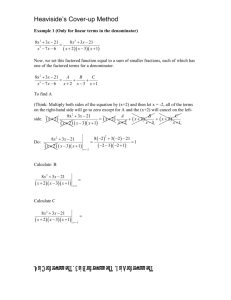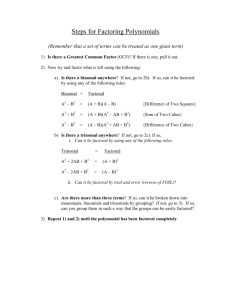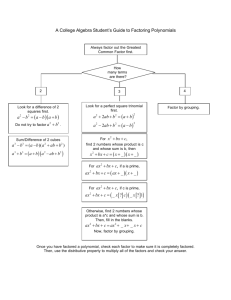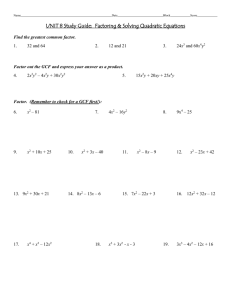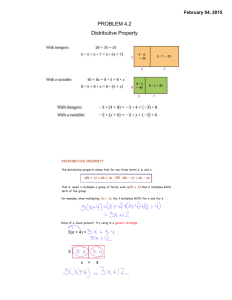1 Overview
advertisement
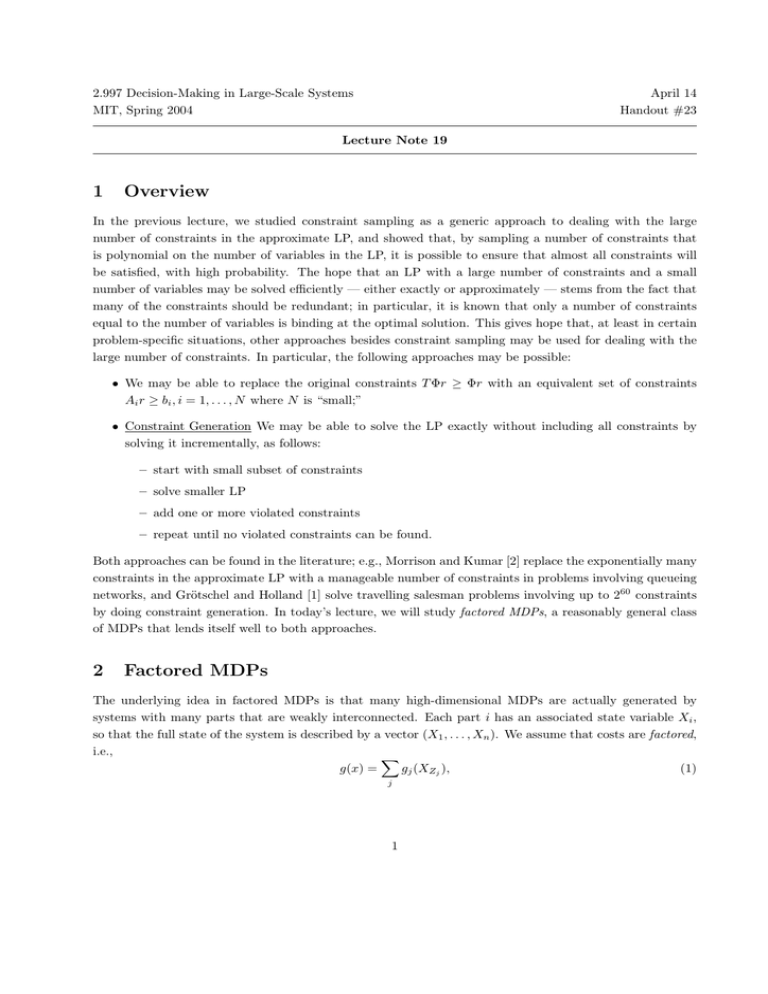
2.997 Decision-Making in Large-Scale Systems
MIT, Spring 2004
April 14
Handout #23
Lecture Note 19
1
Overview
In the previous lecture, we studied constraint sampling as a generic approach to dealing with the large
number of constraints in the approximate LP, and showed that, by sampling a number of constraints that
is polynomial on the number of variables in the LP, it is possible to ensure that almost all constraints will
be satisfied, with high probability. The hope that an LP with a large number of constraints and a small
number of variables may be solved efficiently — either exactly or approximately — stems from the fact that
many of the constraints should be redundant; in particular, it is known that only a number of constraints
equal to the number of variables is binding at the optimal solution. This gives hope that, at least in certain
problem-specific situations, other approaches besides constraint sampling may be used for dealing with the
large number of constraints. In particular, the following approaches may be possible:
• We may be able to replace the original constraints T Φr ≥ Φr with an equivalent set of constraints
Ai r ≥ bi , i = 1, . . . , N where N is “small;”
• Constraint Generation We may be able to solve the LP exactly without including all constraints by
solving it incrementally, as follows:
– start with small subset of constraints
– solve smaller LP
– add one or more violated constraints
– repeat until no violated constraints can be found.
Both approaches can be found in the literature; e.g., Morrison and Kumar [2] replace the exponentially many
constraints in the approximate LP with a manageable number of constraints in problems involving queueing
networks, and Grötschel and Holland [1] solve travelling salesman problems involving up to 260 constraints
by doing constraint generation. In today’s lecture, we will study factored MDPs, a reasonably general class
of MDPs that lends itself well to both approaches.
2
Factored MDPs
The underlying idea in factored MDPs is that many high-dimensional MDPs are actually generated by
systems with many parts that are weakly interconnected. Each part i has an associated state variable Xi ,
so that the full state of the system is described by a vector (X1 , . . . , Xn ). We assume that costs are factored,
i.e.,
�
g(x) =
gj (XZj ),
(1)
j
1
where Zj ⊂ {1, . . . , n} and XZj indicates a (hopefully small) subset of the state variables. Moreover, we also
assume that transition probabilities are factored, i.e.,
Pa (Xi (t + 1)|X(t)) = Pa (Xi (t + 1)|XZi (t)) ∀i,
where once again Zi ⊂ {1, . . . , n} and XZi indicates a (hopefully small) subset of the state variables. In
words, one way of viewing this assumptions is that costs are mostly local to the various parts of the system,
and dynamics are also mostly local, with each state variable being affected only the subset of state variables
it interacts with. Note that, in the long run, if all state variables are directly or indirectly interconnected,
the evolution of a particular state variable may still be affected by all others.
A common way of representing factored MDPs is through a dynamic Bayesian network, as shown in
Figure 1. The nodes at the left and right represent the state variables in subsequent time steps, and arcs
indicate the dependencies between state variables across time steps. This figure may be generalized to include
dependencies within the same time step.
g1 (x1 (t))
x1 (t)
g1 (x1 (t + 1))
x1 (t + 1)
x2 (t)
x2 (t + 1)
x3 (t)
x3 (t + 1)
xn (t)
xn (t + 1)
Figure 1: Each state is influenced by a small subset of states in every time stage
Example 1 Consider the queueing network represented in Figure 2. With our usual choice of costs ga (x) =
�
i xi , corresponding to the total number of jobs in the system, it is clear that stage costs are factored.
Moreover, transition probabilities are also factored; for instance, we have
Pa (x2 (t + 1)|x(t)) = Pa1 ,a2 (x2 (t + 1)|x1 (t), x2 (t)),
since the number of jobs in queue 2 in the next time step is determined exclusively by potential departures
from queue 1 — which depend only on x1 (t) and a1 (t) — and potential departures from queue 2 — which
depend only on x2 (t) and a2 (t).
2
x1
x2
a1
a2
a3
Figure 2: An queueing network
We consider approximating J ∗ with a factored representation:
�
J ∗ (x) ≈
φi (xwi )ri � J˜(x), Wi ⊂ {1, . . . , n}.
Note that, in general, the optimal cost-to-go function J ∗ does not have an exact factored representation.
However, factored approximations are appealing both because, if the system is indeed only loosely intercon­
nected, we can expect J ∗ to be roughly factored, and perhaps most importantly, factored approximations
give rise to decentralized policies. Indeed, note that Q factors associated with a factored approximation J˜
are also factored:
�
˜
Q(x, a) = ga (x) + α
Pa (x; y)J(y)
y
= ga (x) + α
�
Pa (x1 , . . . , xn ; y1 , . . . , yn )
y1 ,...,yn
= ga (x) + α
= ga (x) + α
��
i
yWi
i
yWi
��
�
φ(yWi )ri
i
Pa (x1 , . . . , xn ; yWi )φ(yWi )ri
Pa (xZi ; yWi )φ(yWi )ri
= ga (x) + f (xZi ; r)
since yWi (t + 1) is only influenced by a subset XZi (t) of X(t).
3
Efficient handling of constraints in factored MDPs
We will now show that the approximate LP constraints
�
ga (x) + α
Pa (x, y)φ(y)r ≥ φ(x)r
y
3
can be dealt with efficiently when we consider factored MDPs with factored cost-to-go function approxima­
tions. For simplicity, let us denote each state-action pair (x, a) by a vector-valued variable t = (t1 , t2 , . . . , tm ) =
(x1 , . . . , xn , a1 , . . . , ap ). Then we are interested in dealing with a set of constraints
�
(2)
fi (tWi , r) ≤ 0, ∀ t.
i
The main difficulty is that t can take on an unmanageably large number of values — as many as the number of
state-action pairs in the system. We will show that these constraints can be replaced by a smaller, equivalent
subset. Moreover, we will show identifying a violated constraint can be done efficiently, which allows for
using constraint generation schemes.
The first step is to rewrite (2) as
�
max
fi (tWi , r) ≤ 0.
t
i
Consider solving the maximization problem above for a fixed value of r. The naive approach is to enumerate
all possible values of t and take the one leading to maximum value of the objective. However, since each of
the terms fi (tWi , r) depends only on a subset tWi of the components of t, the problem can be solved more
efficiently via variable elimination. We illustrate the procedure through the following example.
Example 2 Consider
max f1 (t1 , t2 ) + f2 (t2 , t3 ) + f3 (t2 , t4 ) + f4 (t3 , t4 ).
t1 ,t2 ,t3 ,t4
For simplicity, assume that ti ∈ {0, 1}, for i = 1, 2, 3, 4. If we solve the optimization problem above by
enumerating all possible solutions, there are on the order of O(24 ) operations. Consider optimizing over one
variable at a time, as follows:
1. Eliminate variable t2 : For each possible value of t2 ,t3 , we find
e1 (t2 , t3 ) = max f3 (t2 , t4 ) + f4 (t3 , t4 ),
t4
and rewrite the problem as
max f1 (t1 , t2 ) + f2 (t2 , t3 ) + e1 (t2 , t3 ).
t1 ,t2 ,t3
2. Eliminate variable t3 : For each possible value of t2 , we find
e2 (t2 ) = max f1 (t2 , t2 ) + e1 (t2 , t3 ),
t3
and rewrite the original problem as
max f1 (t1 , t2 ) + e2 (t2 ).
t1 ,t2
3. Eliminate variable t2 : For each possible value of t1 , we find
e3 (t1 ) = max f1 (t1 , t2 ) + e2 (t2 ).
t2
4. Solve maxt1 e3 (t1 ).
Solving the problem via variable elimination requires on the order of O(23 ) operations. More generally,
variable elimination leads to exponential reduction in computational complexity relative to the naive approach.
4
The previous example suggests variable elimination as an efficient approach to verifying whether a can­
didate solution r is feasible for all constraints, and identifying a violated constraint if that is not the case.
Therefore constraint generation can be implemented efficiently when we consider factored MDPs with fac­
tored cost-to-go function approximations. Moreover, the procedure described in the example can also be
used to generate a smaller set of constraints, if we introduce new variables in the LP. Indeed, let ei (tZi ) be
each of the functions involved in the scheme (including the original functions f ). Each function is given by
�
ei (tZi ) = max
ek (tZi , tji ).
t ji
k∈Ki
i
For each function ei , we introduce a set of variables utei , where each ti corresponds to one possible assignment
to variables tZi ; for instance, in the example above, we would have variables
01
10
11
u00
e1 , ue1 , ue1 , ue1 ,
associated with function e1 (t2 , t3 ) and all possible assignments for variables t2 and t3 .
With this new definition, the original constraints can be replaced with
i
utfi = fi (ti , r), ∀ti ,
and
i
utei ≥
�
ek (ti , tji ), ∀ti , tji .
k∈Ki
References
[1] M. Grötschel and O. Holland. Solution of large-scale symmetric travelling salesman problems. Mathe­
matical Programming, 51:141–202, 1991.
[2] J.R. Morrison and P.R. Kumar. New linear program performance bounds for queueing networks. Journal
of Optimization Theory and Applications, 100(3):575–597, 1999.
5
